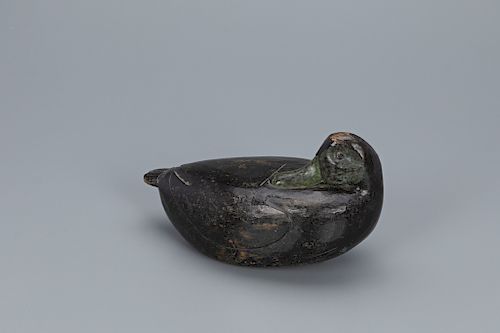Verity Sleeping Black Duck Decoy
Lot 358
About Seller
Copley Fine Art Auctions
20 Winter Street
Pembroke, MA 02359
United States
Founded in 2005, Copley Fine Art Auctions is a boutique auction house specializing in antique decoys and American, sporting, and wildlife paintings. Over the course of the last two decades, the firm has set auction records for not only individual decoy makers, but also entire carving regions. Copley...Read more
Estimate:
$20,000 - $30,000
Absentee vs Live bid
Two ways to bid:
- Leave a max absentee bid and the platform will bid on your behalf up to your maximum bid during the live auction.
- Bid live during the auction and your bids will be submitted real-time to the auctioneer.
Bid Increments
| Price | Bid Increment |
|---|---|
| $0 | $50 |
| $1,000 | $100 |
| $2,500 | $250 |
| $5,000 | $500 |
| $10,000 | $1,000 |
| $25,000 | $2,500 |
| $50,000 | $5,000 |
About Auction
By Copley Fine Art Auctions
Jul 25, 2019
Set Reminder
2019-07-25 10:00:00
2019-07-25 10:00:00
America/New_York
Bidsquare
Bidsquare : The Sporting Sale 2019
https://www.bidsquare.com/auctions/copley/the-sporting-sale-2019-4227
July 25 at 10 am | 550 lots Copley Fine Art Auctions cinnie@copleyart.com
July 25 at 10 am | 550 lots Copley Fine Art Auctions cinnie@copleyart.com
- Lot Description
Seaford, Long Island, c. 1870
11 1/2 in. long
The head and body of this early Seaford decoy are carved from a single block of wood, while the tail is inserted and held in place with wooden pegs. The rarity of this black duck cannot be overstated, with just a single related example held in the Richard McIntyre Collection.
Both Adele Earnest and William J. Mackey illustrate and discuss Long Island sleeping decoys in their books.
Discussing the example in the McIntyre Collection, Mackey states, “Without question a few Great South Bay duck and goose decoys were made before 1850... it is difficult to be specific about which are the oldest Long Island decoys and impossible to state who made them. Better to enjoy the simple fact that some fine, classic examples are available."
Adele Ernest, in her book "The Art of the Decoy," takes an even more ethereal approach when discussing two sleeping duck sculptures: "... a Sumerian duck in the Metropolitan Museum that, in its simplicity of form, does resemble a sleeping duck... But this ancient duck is a stone weight, not a decoy. It is curious that the sensuous, self-contained forms are so similar, although The Artisans were separated by oceans, worlds, and forty centuries of time.” True to her book's title, "The Art of the Decoy," Earnest addresses the universality of appealing form. Working paint with gunning wear.
Provenance: Bud Ward Collection
Capt. George W. Combs Sr. Collection, acquired from the above
Private Collection by descent in the family
Literature: William J. Mackey Jr., "American Bird Decoys," New York, NY, 1965, pp. 95-96, pl. 78, related example illustrated.
Adele Earnest, "The Art of the Decoy," West Chester, PA, 1965, pp. 41-42, related example and Sumarian duck weight illustrated.
Paul A. Johnsgard, "The Bird Decoy: An American Art Form," Lincoln, NE, 1976, p. 60, fig. 52, related example illustrated.Please email condition report requests to colin@copleyart.com. Any condition statement given is a courtesy to customers, Copley will not be held responsible for any errors or omissions. The absence of a condition statement does not imply that the lot is in perfect condition.Condition
- Shipping Info
-
Shipping info
Copley Fine Art Auctions does not handle the shipping of any items. Shipping is the sole responsibility of the buyer. Once your payment has cleared, and we have received your authorized shipping release form items may be released for shipment. Copley Fine Art Auctions, LLC shall have no liability for any loss or damage to such items. Buyers should allow up to four weeks for shipment.Please be aware that internet bidders may NOT not pick up their items at the sale. Items will be available for pick up by appointment or by shippers five days after the sale.
-



 EUR
EUR CAD
CAD AUD
AUD GBP
GBP MXN
MXN HKD
HKD CNY
CNY MYR
MYR SEK
SEK SGD
SGD CHF
CHF THB
THB














